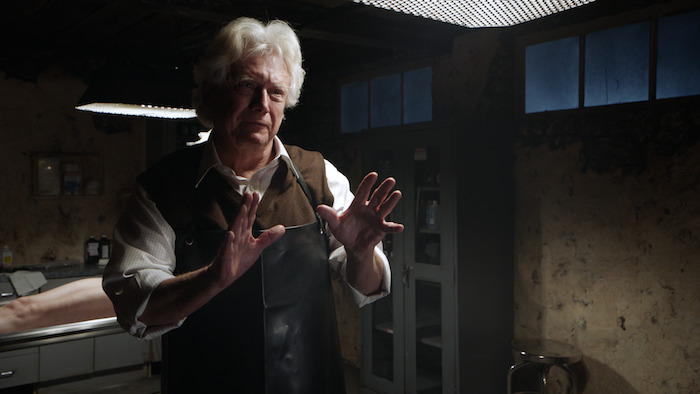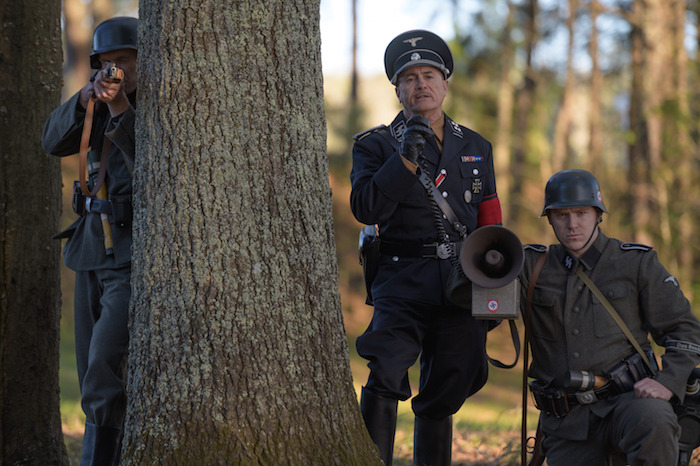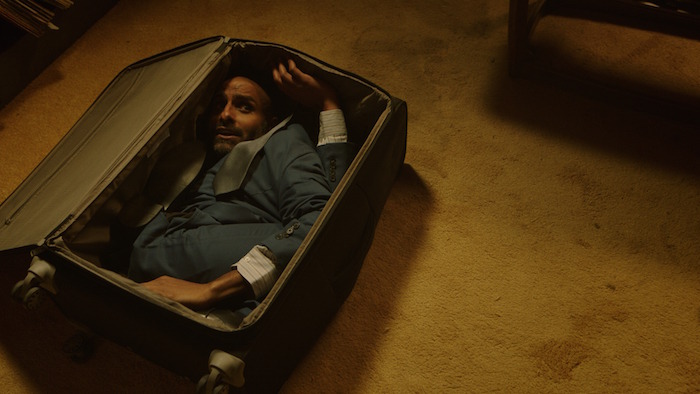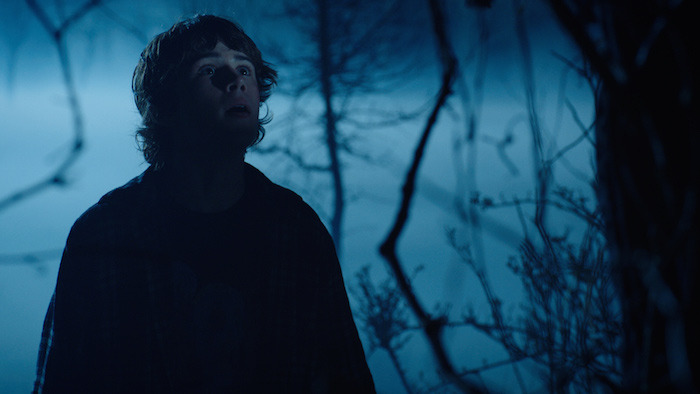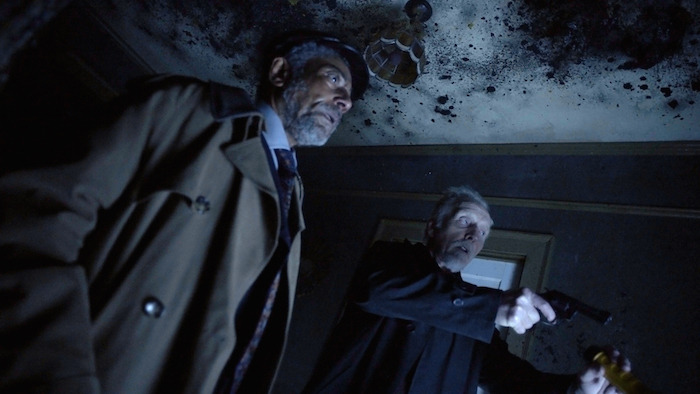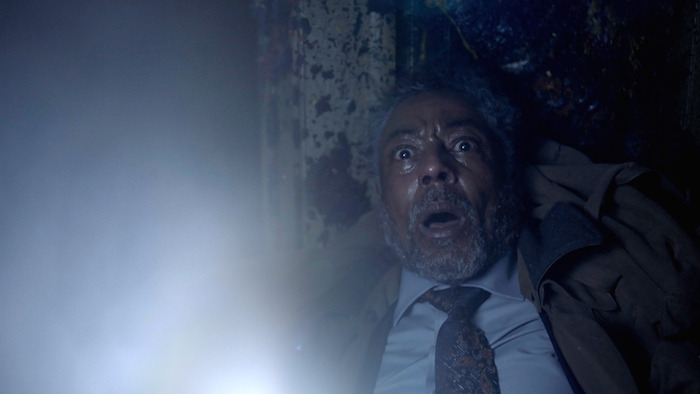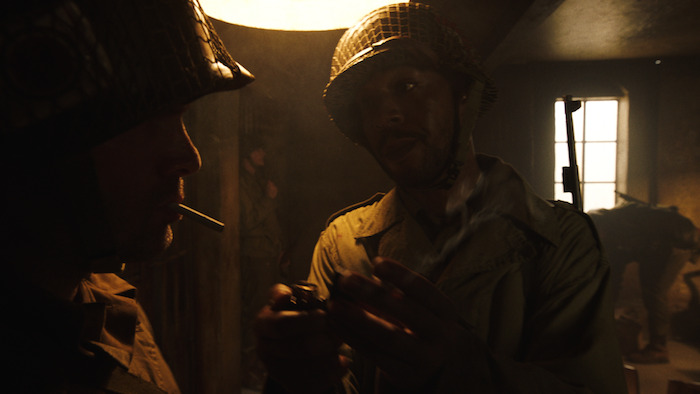The Art Of Decapitating A Nazi: Exploring The Blood-Splattered Set Of The New 'Creepshow' [Set Visit]
It's after midnight and the werewolf can't quite decapitate the Nazi.
I'm on the set of Creepshow in Atlanta, Georgia and it's a classic case of "hurry up and wait." The crew stands ready. Actors in werewolf costumes linger off-camera, waiting for their big close-ups. The clock is ticking. But director Rob Schrab and executive producer Greg Nicotero are having a discussion. Or a disagreement, rather. It's not quite an argument, but it could get there.
You see, Schrab wants the werewolf to decapitate the Nazi with a purely practical effect, with those giant claws ripping the head off the shoulders with a geyser of gore. Nicotero, a legendary practical effects guru and executive producer on The Walking Dead, thinks they should do one blood-free take. Just in case they screw up the wet version. Just in case they have to digitally add blood. Just in case it's the only option they have in post. Schrab is resistant – this needs to be old school.
I have been on many set visits, but I have never had the pleasure of watching two filmmakers have a heated conversation about filming a werewolf decapitating a Nazi in a horror short about German soldiers who surround the wrong American soldiers during a full moon. But this is the set of the Creepshow TV series, where things move fast and the blood flows everywhere and conversations about the most gruesome concepts imaginable are the norm.
The Monster Closet
Before it became a new streaming television series coming to AMC's Shudder service, Creepshow was already a horror legend. The 1982 film featured a series of grisly horror tales, all of them directed by the legendary George Romero and written by genre royalty Stephen King. The film was a tribute to old-school horror comics, a mixture of thrills and chills and monsters and gore, all filmed with a tongue firmly in cheek and a color palette that felt ripped from EC Comics.
The new series will feature two distinct horror tales per episode, each one running about 18 minutes, each one directed by a different filmmaker. Up-and-comers and horror legends alike are behind the scripts and behind the cameras. The only requirement: they must keep up with the show's absurd schedule. Under the supervision of Nicotero, each segment is filmed in a blistering three-and-a-half days. Everyone on this set would be tired if they had the time to be tired.
We arrived on the Creepshow soundstage alongside Schrab, who was still 12 hours away from debating Nazi decapitation. Nursing a coffee, he explained his segment, titled "Bad Wolf Down." It's a vengeful Nazi officer, played by horror icon Jeffrey Combs, versus a trio of American soldiers (led by Kid Cudi) who also happen to be werewolves. Each soldier is based on a classic cinematic lycanthrope: one is Lon Chaney's fully upright Wolf Man, one is the shaggy, long-haired beast from The Howling, and one is the four-legged wolf from An American Werewolf in London. He describes it as the Avengers of werewolf stories.
That premise, outrageous and awesome in equal measure, feels like classic Creepshow. And it's made all the more enticing because we have this conversation right outside of what can best be called the "monster closet." Because Creepshow is shot so quickly and because it goes through an absurd number of monsters and corpses on a daily basis, this cramped storage space is where the crew hides the bodies. Literally. Kind of. Shelves stacked with severed limbs and ruined torsos. More than a few bloody heads, faces still wearing expressions of shock. Monster carcasses, puppets, foam creature suits that look like they were heavily used before being placed here. If you don't faint from the overwhelming scent of latex and foam, it's a space that quietly demands for you to explore every nook and cranny.
It's Creepshow in a nutshell: everyone involved is truly swinging for the fences and every story will be full of more monsters and mayhem than you imagined. After all, they need a dedicated closet to stash the creatures. If that doesn't excite you, you probably aren't the target audience here anyway.
Creepshow Comes to Life
We're sitting behind Schrab, watching as the director stares into the monitors. And on those monitors: Re-Animator star Jeffrey Combs, one of the horror genre's finest performers. He's dressed in a Nazi uniform and kneeling by the body of a dead soldier. His son, we soon learn. He vows vengeance against the American soldiers who killed his boy. His face twists into a scowl and someone off-camera shouts a cue and the lights change. The naturalistic lighting shifts – green splashes over Combs' face and body while the background behind shifts to a fiery red. Combs holds his pose, the image transformed, in-camera, into a living comic book panel. It's the kind of thing that could have been done in post. But not here. They did in on set, in a soundstage, live in front of their cast and crew.
Schrab is, to put it mildly, pleased with the results. He calls over Nicotero and other members of the cast and crew to take a look. Everyone smiles. That color scheme, that stylized comic book look...yep, that's Creepshow.
As they return to do another take, the half-suited werewolves arrive to warm up. Two of the werewolves are actors in costumes, both still human from the waist-up, but transformed down to their feet. It's too hot to be fully dressed and they won't be actually filming for a few hours. But they practice their movements and prepare for a shot that will see one of them lying on his stomach on a dolly for a POV shot where he hunts down Combs and rips the jaw from his head.
But where's the third werewolf? He's going to be a puppet, we're told.
A Maze of Gore
The Creepshow soundstage could be mistaken for a maze. There are a half-dozen or more constructed sets sharing the space, all of them built around each other to maximize space. Many are elevated off the ground to allow for puppeteers and effects artists to work their magic beneath the floor. Others are from the earlier episodes and are being carefully re-dressed to be used again for another story. Icy corporate hallways lead to filthy domestic living rooms. Tidy garages lead to foggy forests. The variety of sets is genuinely astonishing and the crew we speak with recounts how certain sets have been used and re-used, requiring a turnover that would seem impossible to anyone who is not on the seemingly unstoppable production design crew.
However, one thing unites every set we visit: the blood. Seriously. When the crew finishes with a set on Creepshow, the ground and the walls are coated with gore and viscera. Our tour takes us through dozens of rooms and each of them looks like a crime scene. Hearing our guide casually describe the atrocities that have been filmed in each room grows steadily more amusing. This is where one character was crushed to death. This is where the cast was devoured by monsters. This is where...you get the drill.
The sets expose Creepshow for what it is: a scrappy production. The sets are often small, meant to be extended through the right lens choice and careful framing. Flexibility and speed is the name of the game here. But that's perfectly fine – the best horror films are often scrappy and this is a show built entirely around producing tons of scrappy horror stories for your streaming pleasure.
How to Move a Dinosaur
We're sitting across from Tom Savini, the legendary special effects make-up artist who worked on the original Creepshow movie. And Friday the 13th. And Maniac. And Dawn of the Dead. He's kind of a big deal, to put it mildly. We're asking him about the Creepshow TV series segment he's directing, which is about two kids who discover a dinosaur near their house, the source of a local legend about a sea monster named "Champy." But as Savini is prone to do, he's off-topic. He's telling us about Vietnam. And how the movies saved his soul:
When I came back from Vietnam, I was a zombie. I was an emotionless zombie. My marriage went right in the toilet. I can't live without love in the house and I don't blame her at all. I was just not there anymore. I wasn't even on the front lines. Guys that came from the front lines, you looked at them and they weren't there. So I was like that for about two and a half years. A movie brought my emotions back. When I went to see Midnight Cowboy, when Dustin Hoffman died, I became hysterical. My wife and my friend were the last people in the theater because I was crying so hysterically. And then when I left, I broke down again outside. It wasn't sad that Dustin Hoffman died, but it was all pent up from – we didn't call it PTSD. It was all pent up. From that day on, I was able to enjoy a sunset. I had feelings after that. My feelings came back.
Savini is opinionated, especially about horror. He hates Hereditary. He thinks too many modern movies are too quick to show the monster. But he never comes across as bitter. In fact, he seems very happy to have an audience of horror geeks hanging on his every word. He knows this genre, this industry, like few others. So when he speaks kindly of Greg Nicotero, you know he means it...especially since Nicotero's first job was working for Savini back in 1985:
I've known Greg since he was 14. He was a little kid, visited the set of [Day] of the Dead. He was my assistant on a couple of movies I did, and I said to him – he mentions me at awards ceremonies and things, and we're in his hot tub, and I said, 'Greg, you would have all of this if you had never even met me.' Because he's a hard worker. He's incredible. He was this little kid – he was gut boy on Day of the Dead. He handled the pig intestines for us.
Later on, we're invited to watch them move Champy the dinosaur. He's a practical effect, a dinosaur about the size of a truck. The indoor set recreates a beach and the nearby foliage. The room will be filled with fog to complete the illusion. But right now, it's just Savini carefully orchestrating his crew as they gently lower Champy into place, inching him back and forward, left and right, until the dino is right where Savini wants him. They get there. It's just right. Everyone leaves. Savini begins filming his segment the next day.
The Hardest Working Man on Set
Greg Nicotero visited the Pittsburgh set of the 1982 Creepshow before George Romero and Tom Savini hired him as a "gut boy" in 1985. Nicotero would then work on Creepshow 2 before co-founding KNB, one of the most respected effects studios in the industry. Now he's an executive producer on The Walking Dead, a job that has taught him to work fast and dirty on TV budget. And a job that led him directly to Creepshow. AMC makes The Walking Dead and AMC owns Shudder, so when Nicotero learned that he had a direct connection to the reboot, he leapt at his chance to resurrect the name and pay tribute to the icons who helped put him on the map. This isn't just a passion project. It's personal.
And yes, he admits that the crazy schedule may have been a bit much, but he also found himself blown away by the crew:
I got greedy. I'll be really honest. I wanted to tell as many stories as I could. I just thought if you're going to do Creepshow, it's not one story [per] hour. It just didn't feel right. So we really jumped into the whirlpool deep, but thank God the crew that we had, and Aimee Holmberg our production designer, and the makeup effects guys and everybody, it's been amazing. The fact that nobody's ever said, 'No, we can't do that.' They've always been like, 'Well, we should do this.' You walk on set and you're like, 'Holy fuck, how'd you guys do that in three days?' We built a set, you shoot on it for three days, you go to another set and shoot on it for three days and you walk back, and it's completely rebuilt into a different [thing]. How do you do that?
But the "fast and dirty" approach is baked into the show's DNA. Nicotero has plenty of praise for his crew and his writers, seeing the anthology approach as a way for as many people as possible to tell the horror story they've always wanted to tell. He spoke about the virtues of being able to tell brisk, one-off stories:
I think it's a matter of choice. I love character stuff, but this particular show is just not that medium, even though we have great characters. But there's a lot to be said in this day and age for bite-sized meals in terms of people want to come and they want to watch something for twenty minutes and then go off and do something else and come back and watch another thing, you know what I mean? Or they watch more of this for some crazy reason. A good reason! So that's hard to say, because I love them all. And what's great is, you were talking about the horror genre and television, every time a horror movie comes out and does well, it bodes well for all of us. I saw Us the other day, and it's so much fun. I love going on these journeys where I have no idea – I don't watch trailers, I don't read anything, I have no idea. So generally, I just want to be entertained. Just take me on a journey and I'll have a good time. So I had a great time, and I like that these movies – I loved Hereditary. It's just fun. Mandy, I couldn't quite – I really wanted to love it, but I was like, 'What the fuck!' My fifteen-year-old son's like, 'Dad, let's watch this movie,' and I was like, 'It was crazy.' But, you know, fun.
When someone tells Nicotero that Tom Savini didn't like Hereditary, he sighs and jokes: "Ugh, he's an idiot."
One Nasty Room
Nicotero may be running Creepshow, but he also took the time to direct a segment of his own. That segment is "Gray Matter," based on the short story by Stephen King. The story, which was collected in King's Night Shift, tells the story of a man who drinks the wrong beer and mutates into a strange amoeba. It's weird and gross and just simple enough to fit right in with Creepshow.
The Gray Matter set is still standing during our visit and Nicotero himself swings by to offer us a tour. It's a living room, trashed to oblivion, with dark fungus growing all over the walls. In the middle of the room is a chair, where the slowly mutating character at the heart of the story plants himself. It's filthy. It's great.
And yes, Nicotero has an anecdote about shooting in here:
I read a bunch of his stories two years ago when we were talking about developing something as a feature. And that one popped into my head when we started getting all the other drafts of the scripts in, I'm like, 'Dude, we should be doing Gray Matter.' I got my beer on the desk, and it's literally like Slimfast chocolate. And the actor that played Richie drank like thirty of them in a day, and I was waiting for him to fucking spew. He probably lost twelve pounds. I was waiting for him to vomit chocolate milk all over the set. I felt so bad. 'Cut, and let's go again,' and he was [dejected].
How to Decapitate a Nazi
Time is running out. Schrab and Nicotero need to decapitate this Nazi because they have to kill a bunch of other Nazis tonight. The werewolves are getting restless. The crew stands by. Ultimately, Nicotero convinces Schrab to do a "dry" take of the decapitation. They do it. The head flies off the shoulders of the mannequin. It lingers. And then it falls.
The crew resets. Tubes hooked to a tank of fake blood are run up the neck of the Nazi's body. The head is carefully placed back on the neck. Nicotero offers advice to the guy operating the blood pump about his timing – after all, he's done this a hundred times and they only have one shot at this.
Schrab calls action. The werewolf swipes. The head flies off. A geyser of red gore shoots from the neck of the soldier and his body topples to the ground. They nailed it.
And while it is late, the night is still young for the crew of Creepshow. They have more Nazis to kill. They have more werewolves to film. They have more blood to spill. And tomorrow, they'll do it again.

